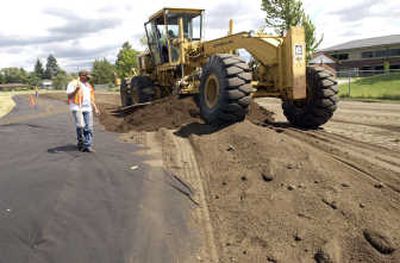Playground gets safety makeover

Over the next several days, crews will cover the playground at Progress Elementary with 6 to 8 inches of new dirt to seal in soil contaminated by pesticides from Spokane Valley’s agricultural past.
After soil testing at new home sites in the central part of the state began turning up high levels of lead and arsenic on former orchards several years ago, the Legislature set aside money to test properties frequented by children that may be polluted by a pesticide popular in the first half of the last century.
Several school grounds have been tested in Spokane County, but “this is the only one we have a problem at, thank goodness,” said site manager Sandra Treccani of the Washington Department of Ecology.
Parts of the playground had higher concentrations of both pollutants than are considered safe. There has been little risk to students, though, because the soil is covered by sod or imported sand in places like the baseball diamond, said Mike LaScuola.
He and others at the Spokane Regional Health District pieced together a mosaic of old aerial photographs to determine where the orchards were in Spokane Valley and Deer Park.
Most sites in the Valley turned out to be small truck farms as opposed to large industrial orchards that could afford to use the expensive pesticide, he said, and testing showed unhealthy levels of the chemicals only at Progress Elementary, 710 N. Progress.
There, environmental officials put together a plan last year to dilute the contaminated soil with clean dirt using a large tiller.
After rescheduling the project for this summer they decided to cap the site instead, citing issues with rocks and ground settling where tilling had been done in other parts of the state.
A membrane similar to the felt weed barrier many people use in their gardens will be rolled over the existing grass and new dirt placed on top of it, Treccani said.
The plan calls for most of the work to be completed by the end of next week so new sod and grass seed can be planted well before the start of school, she said.
Using money raised by the Parent Teacher Student Association, two new sets of playground equipment are scheduled to be installed by the second week of August, said Progress Elementary Principal Matt Chisholm.
Both will have simulated rock walls and a variety of other climbing surfaces, as well as interactive musical elements. One will be designed with younger students in mind.
The basketball hoops, tetherball poles and swings will remain.
During the soil capping, small areas around sprinkler heads will be the only places where soil underneath the existing grass will be exposed, Treccani said.
Both lead and arsenic have been shown to increase the risk of cancer and other diseases. Lead exposure can damage organs and is associated with several nervous system problems.
Most lead poisoning occurs when children are exposed to aging paint containing the heavy metal. It’s also present in the soil around many houses where lead paint on the outside dripped into the soil or was washed there over time, LaScuola said.
Children aged 6 and younger are most at risk of lead-contaminated material entering the mouth or lungs.